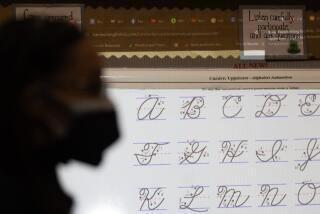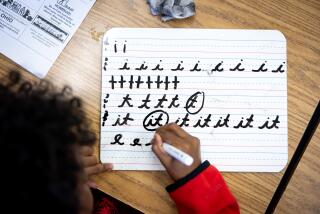Writing Lessons Are No Longer Limited to English Classes
- Share via
You may have noticed that your child is doing more writing as part of his or her homework, even for subjects that usually don’t entail writing, such as math or art.
Don’t be alarmed. This is part of a teaching trend called “writing to learn.”
Writing to learn began in the early 1980s, when it was called “writing across the curriculum.” Now it has found new steam--along with its new name--and is being encouraged in schools throughout Los Angeles County and in many other places.
The underlying premise is that writing down something is one of the quickest and most lasting ways to learn and remember it. You may not fully realize how much (or how little) you know about a topic or concept until you try to explain it in writing.
Writing, in other words, is a tool of intellectual discovery--so it is a waste to confine writing assignments just to language and literature classes.
Teachers of all grades and subjects are attending workshops to learn how to integrate writing into their lesson plans.
At first glance, this may seem an unrealistic goal. I’m usually open-minded about new teaching methods, but my first response was, “What on earth will physical education teachers do with writing?”
Many teachers of subjects that don’t normally involve writing have also had reservations. They were concerned, for example, that they might not know rules of grammar well enough to evaluate a lot of written work.
They should be reassured. Writing to learn doesn’t necessarily mean writing flawlessly, and grammar lessons can still be left to the English teachers.
Instead, teachers of traditionally non-writing subjects should focus on improving the fluidity, detail, and clarity with which their students think and write.
In many cases, students are asked to write down their thoughts quickly and freely--without concern for grammar, spelling or punctuation--for a few minutes during class. This is called a “quick-write” and is probably the most popularly used writing-to-learn method.
In a quick-write, students may be asked to recap what they remember from the previous night’s assigned reading. Or, at the end of the class, they may write about what they learned during the class period.
These exercises are also helpful for the teacher, because they make it possible to monitor the students’ understanding and check their progress.
In addition, students who keep quick-writes in their notebooks soon have a nicely organized set of notes to study from for exams or research papers.
Some teachers are using writing in ways that are quite creative. A survey of my colleagues at Santa Monica High School provided these examples:
* A math teacher has students write their own word problems, especially when the textbook’s problems are outdated in terms of prices or interest rates.
* A physical education teacher has students prepare papers on their families’ health histories after they interview relatives about various health factors.
* An algebra teacher asks her students to write about how they would describe certain tricky concepts over the phone, since they could not use visual aids and the words must be precise.
* An art teacher has her students sculpt a tableau that portrays a scene from their lives 10 years from now. They also write about where they are, how they got there and how satisfied they are. The scene and writing are then exhibited.
* An auto shop teacher eases his students into the semester by having them write about their favorite experience in an automobile (not involving the back seat). And every Friday, the same teacher requires a written report on a current event relating to transportation in general--whether it’s the Big Three’s quarterly losses or the sale of B-1 bombers.
In most cases, writing forces students to imprint and organize knowledge in their minds, and helps them to see relationships between facts and even whole subjects.
It is, in other words, an idea whose time has come.






